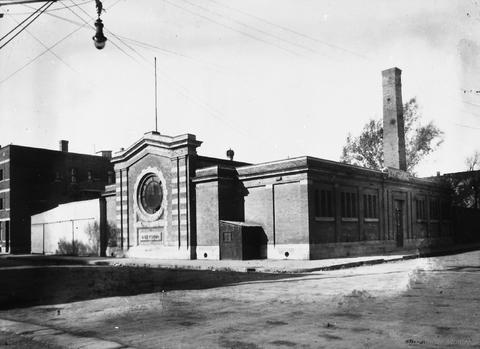
Turcot Bathhouse, 1920s. City of Montreal Archives, VM94-Z409
The decision to annex the Town of Saint-Louis to Montreal was made during the summer of 1908; it would come into effect on January 1, 1910. Mayor Napoléon Turcot decided to use the last months of independence to provide the residents of what would soon become Laurier Ward with one last major civic accomplishment, apart from the Saint-Laurent Boulevard underpass: a public bathhouse. He announced his plans at a town council meeting held on August 18, 1908. It was a necessary public health measure, he said, one which would benefit the working-class population, “given the great number of homes without bathtubs.” This new, unexpected public expenditure surprised the town councillors, especially since Saint-Louis was heavily in debt. Turcot assured them: “The project won’t be that expensive, given the coming annexation,” implying that Montreal would absorb the costs.
The Turcot bathhouse on Saint-Dominique Street opened in October 1910. Designed by architect Zotique Trudel, the bathhouse has a Beaux-Arts façade with an oversized oculus window, like a grand theatre. As such, the building is quite different from the utilitarian architecture used for public baths previously constructed in Montreal (though many other striking bathhouses were built during the following quarter-century). In addition to the bathtubs and showers for hygiene, the building included a pool, where neighbourhood children could take swimming lessons. Like many of the public baths of the time, it was given the name of the local city councillor – none other than former mayor Napoléon Turcot, who became the ward councillor after his town was annexed.
In 1937, the bathhouse was renovated from top to bottom at the initiative of city councillor Dave Rochon. It was then renamed in honour of the municipal ward, Saint-Michel (the name of the district, separated from Laurier Ward in 1921, refers to the Irish-Catholic parish of St. Michael the Archangel).
The swimming pool closed in 1994, due to its state of disrepair (once the new swimming pool at the YMCA became available). Bain Saint-Michel was adopted as a performance space by emerging artists in 1998. In 2003, it also became the principal stage for Infinitheatre, an independent English-language theatre troupe.
Due to its poor structural condition, the building closed in 2014, to undergo restoration and interior redesign. The renovation turned out to be much more complex than expected; the completion date was delayed to 2022, then 2025. The plans announced in 2021 were that the building be used for cultural purposes, co-managed by members of the arts community and the Plateau Mont-Royal borough.
Research and writing: Yves Desjardins et Justin Bur, 2018
Translation: Joshua Wolfe, 2021 / Updated Oct. 2022

Quand on parle de bain public, est-ce que c’était des douches ou des bains individuels que l’on mettait à la disposition des citoyens ?
Bonjour,
Un article, publié par La Presse le 10 juin 1911, nous apprend que l’édifice disposait de « huit bains orage, trois bains privés et six lavabos, tant à l’eau chaude qu’à l’eau froide. » Il y avait également des douches, obligatoires avant d’utiliser la piscine. L’article ajoute que le Bain est fréquenté par 1 500 personnes par semaine.
Pourquoi ne pas laisser son nom d’origine à ce lieu, témoin de Notre histoire. Le maire Turcot, fondateur de ce bain public, appellation qui se trouve intégrée à la façade du bâtiment, convient parfaitement. Si nous étions anglophones, et comme ils sont si respectueux de Leur histoire, nul doute que BAIN TURCOT, ne saurait être remplacé par une quelconque dénomination, aucunement porteuse de sens historique et donc, affectif. Nous perdons du terrain à chacune des étapes de restauration de notre ville. Comme si la crainte du jugement dernier planait sur nos têtes dirigeantes. Osons regarder les choses en face: nous ne semblons jamais assez fiers de notre patrimoine pour en démontrer notre attachement.
Ça fait très longtemps que les gens du quartier, toutes origines confondues, ont choisi de supprimer le nom de Napoléon Turcot, un politicien qui ne faisait clairement pas l’affaire de tout le monde. Le nom de remplacement est aussi un témoin de notre histoire et notre patrimoine, car c’était pendant un demi-siècle le nom officiel du quartier municipal qui, en plus, fait référence à une église-phare du quartier, Saint-Michel-Archange au coin des rues Saint-Viateur et Saint-Urbain. Pourquoi devrait-on maintenant réanimer un fantôme du passé?